The Gray Market
8 Highly Specific Predictions for the Art Industry in 2023 (Including an Art-Fair Death Foretold)
Our columnist mans the fortune teller's booth again to try to envision what awaits the art world in the year ahead.
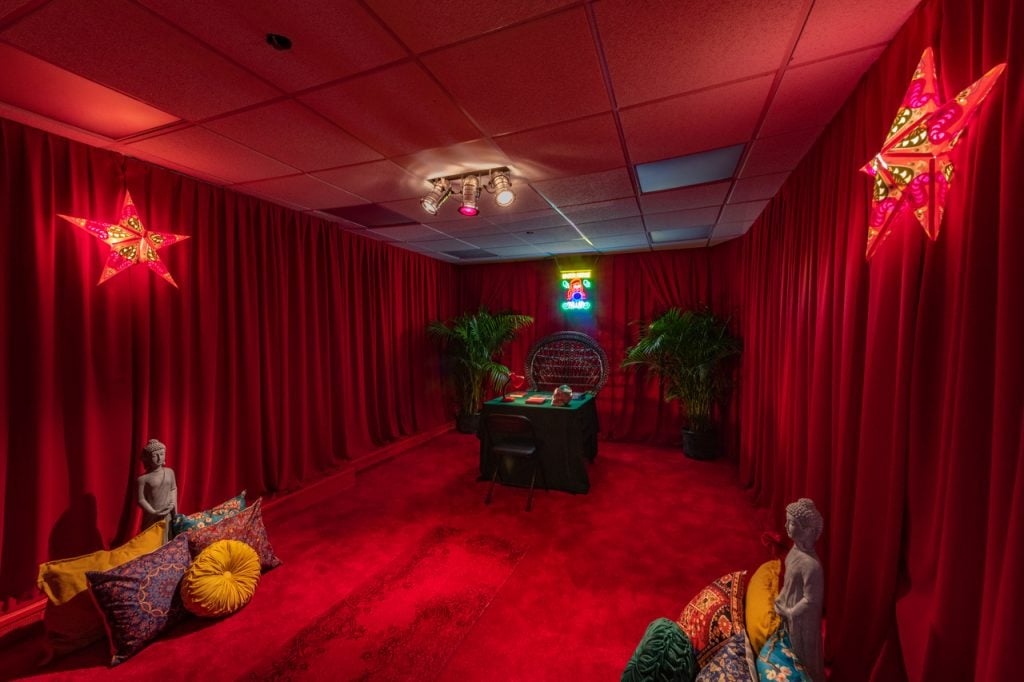
Our columnist mans the fortune teller's booth again to try to envision what awaits the art world in the year ahead.

Tim Schneider

Every week, Artnet News brings you The Gray Market. The column decodes important stories from the previous week—and offers unparalleled insight into the inner workings of the art industry in the process.
Another trip around the sun begins with a Gray Market tradition.
Longtime readers know the drill by now: I devote the first column of every year to making a set of predictions about multiple sectors of this perennially bonkers industry, all of which can be objectively, definitively proven true or false in December. Then, I use the last column of the year to grade myself, including some notes on why I was right or wrong in each case. (Here’s my report card for 2022, if you missed it.)
O.K., enough explaining. Here we go again…
I don’t have the data to prove it, but I would bet my job that one of the fastest-growing segments of the art economy over the past 10 years has been licensing deals for artists and estates, with artist-branded merch being the most frequent outcome.
Many, if not most, premier-league dealers now operate the equivalent of museum gift stores. (Gagosian opened its second standalone shop in London last year.) The Jean-Michel Basquiat estate runs a merch empire that offered everything from $3 postcards to $75 alpaca blankets to $1,300 Coach bags at its “King Pleasure” exhibition in New York last year. Artists are becoming muses to, and collaborators with, more and more of fashion’s brightest names every year.
And yet, it’s possible that galleries are falling behind in the licensing race. The Basquiat estate works with an independent advisor on this front. My colleague Katya Kazakina reported last year that the Warhol Foundation and the Artists Rights Society both maintain multiperson licensing departments, with the latter “[attending] trade shows in Las Vegas along with conglomerates like Disney and HBO, building bridges between artists, their estates, and big brands.” The three largest entertainment agencies (CAA, Endeavor, and UTA) all employ specialists who work with contemporary artists on transmedia opportunities and licensing deals.
Major galleries (even those with shops) have generally considered all of this a side business worth only limited bandwidth, but will they stand pat as the licensing pie keeps getting bigger and juicier? Potential profits aside, are they content to cede influence over how some of their most bankable artists broker their time, work, and reputation to outside parties? Or will at least one gallery staff up with their own licensing experts to help ensure their talent never has to go elsewhere to scratch this increasingly appealing itch?
I’m gambling on the last of those being a yes in 2023.
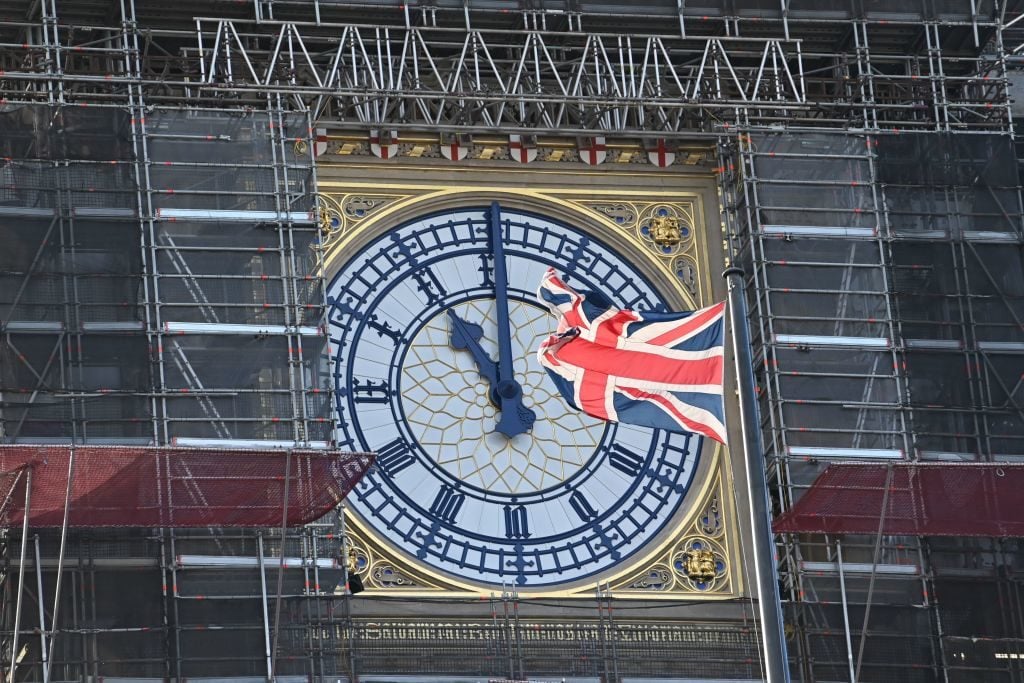
Like the renovation of Big Ben, Brexit is currently a work in progress. Photo by Justin Tallis/AFP via Getty Images.
From a macro standpoint, the U.S. economy continues to be extremely weird. High (but easing) inflation, the loftiest interest rate in 15 years (with more hikes on the way), and the first honest-to-goodness bear market for stocks* since the Great Recession have all done little so far to cool off a hot hiring market and rising wages.
(*Technically, the last bear market in the U.S. began in mid-February 2020 as COVID spread in earnest around the globe. But the downturn only lasted 33 days, and stocks went on a two-plus-year rally starting in late March of that year.)
The picture in China and Great Britain looks both clearer and darker. Coronavirus infections have been raging through the former since Xi Jinping abruptly reversed three years of notorious “zero-COVID” policies in December, and a troubled domestic real estate market may have already plunged the country into what one Hong Kong-based consultant called “a slow-motion financial crisis.”
Meanwhile, the U.K. looks to be in rough shape after years of policy bungling and the poisonous flowering of Brexit. But don’t take my word for it: a “clear majority” of the 101 economists who responded to a recent Financial Times’s survey expected Britain to “face one of the worst recessions and weakest recoveries” among G7 nations in 2023.
None of this is good news for the global art market. At the same time, it’s much worse news for China and the U.K. than for Uncle Sam. Rather than try to anticipate the impact of these headwinds on the overall fine-art auction economy, I’m focusing on the biggest victims individually. (Exercising a little more restraint is one of my New Year’s resolutions.)
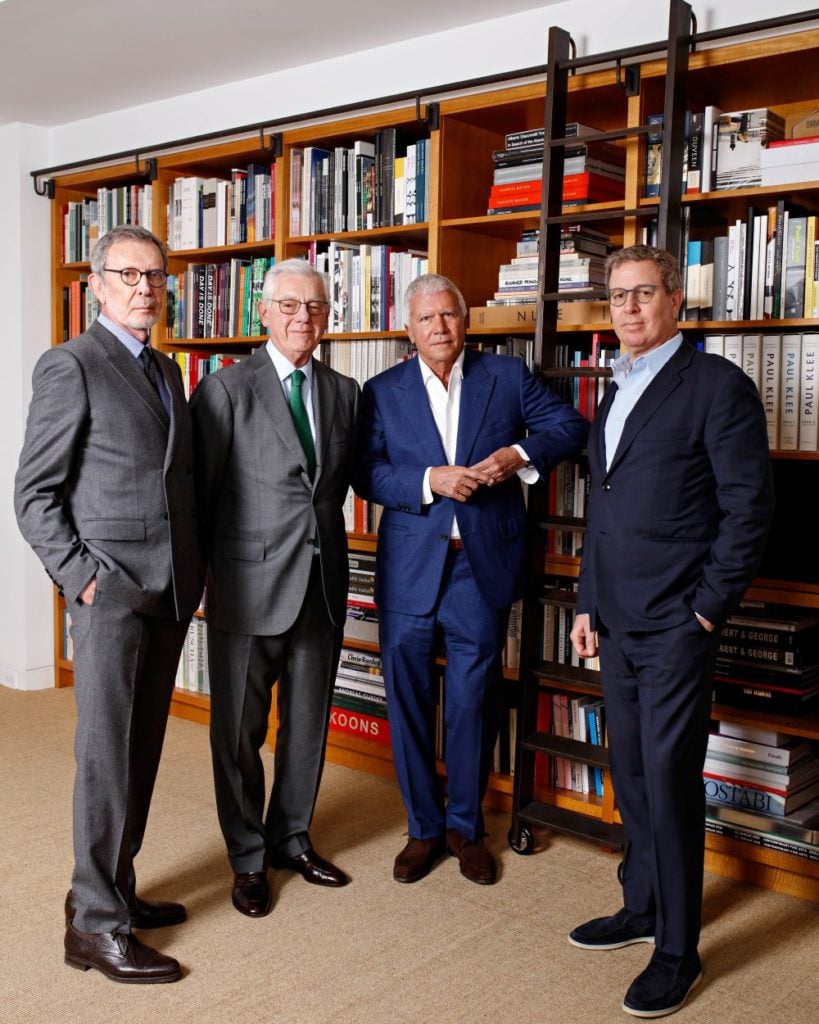
From left to right: Arne Glimcher, Bill Acquavella, Larry Gagosian, and Marc Glimcher. Photo © Axel Depuex.
Remember when these three apex galleries joined forces to sell the $450 million Donald Marron estate in February 2020? Remember when Pace founder Arne Glimcher later told the Wall Street Journal that the partnership had been cemented as an independent entity to bid for more major collections in the future? Remember how collectors tend to pivot to the private market once the auction game stops consistently generating above-estimate results for trophy lots?
While Christie’s, Sotheby’s, and Phillips coaxed plenty of big prices out of top bidders in 2022, what stuck with me was the high proportion of lots in the $10 million+ range that hammered below their estimates or failed to find buyers at all. Amid the shaky economic forecast, that trend might make the major houses more conservative with their guarantees to consignors in the year ahead.
That, along with the added discretion of private sales, could create enough of an opening for AGP to play the spoiler again. The Glimchers, Gagosian, or the Acquavellas might still need another unusually strong pre-existing relationship with the consignor, just as they had with Marron. But the ingredients are in place.
It’s been awfully quiet at RX France, FIAC’s parent company, since the warm welcome given to Paris+ in FIAC’s former venue and time slot last October. More than the healthy sales and the largely happy usual suspects on the international art circuit, the most ominous sign for FIAC’s future was the French political and cultural elite’s attendance at Art Basel’s fair. President Emmanuel Macron, culture minister Rima Abdul Malak, Louvre director Laurence des Cars, and more all joined in the festivities. That had to feel like a body blow to officials at RX France, whose best hope to salvage the homegrown FIAC after its sudden eviction by a Swiss company was the support of its countrymen. So much for the whole “fraternité” part of the national motto….
Sheer numbers are against FIAC, too. Paris+ hosted 156 exhibitors at its hurriedly organized first edition. It’s pretty standard for that number to rise by 10 to 15 percent in the second edition of any new fair. The scrappier but well regarded Paris Internationale fair hosted another 60 dealers alongside Paris+ and should be able to maintain something close to that cohort in 2023, if not more. Together, then, the two fairs will probably be able to host some 230 exhibitors spanning the emerging to high-end tiers.
Will there be enough quality galleries to justify FIAC’s return in a year likely to be defined by cost-cutting? I get no joy from saying that I doubt it.
Nor is it encouraging that, rather than hiring or elevating a full-time director to chart FIAC’s future, RX France simply tasked the director of its other fair brand, Paris Photo, with running both events almost a year ago. I’m automatically skeptical when a lead executive is supposed to pull double duty. In this case, the bad signs look even worse when a result of that lead executive managing two art fairs is that one of those art fairs didn’t happen at all in 2022. If FIAC is AWOL this year, too, I don’t think it’s coming back.
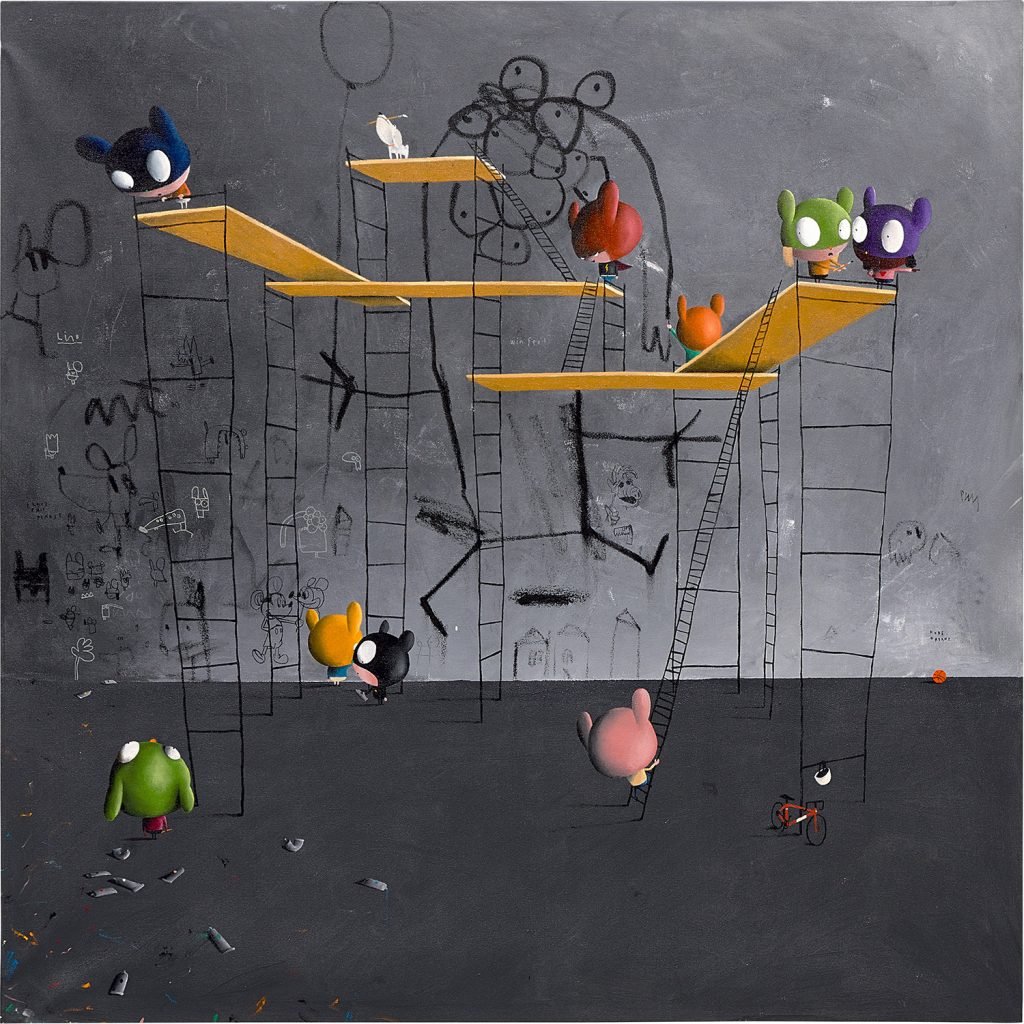
Edgar Plans, My Little Monster Loves Balloons (2020). Image courtesy of Phillips.
To recap a bit, the good macroeconomic news is that U.S. inflation—even though it’s still high—is de-escalating somewhat. But a big part of the reason it’s de-escalating is that interest rates are the highest they’ve been in decades. Worse, the Fed is saber-rattling about continuing to hike rates even further in the coming months, a sharp reversal from when it openly assured Americans that it would keep rates at or near zero from 2010 until last year.
The change is good on paper if you’re holding investment-grade art. High interest rates mean investable assets of all kinds become more expensive, which means anyone who already owns them is theoretically getting richer. But it’s not so good if you want to sell what I’ll call speculation-grade art, or works by hot (usually) young artists whose resale prices rose scary fast during the last bull market on the expectation that they would become permanent blue-chippers… or at least enable a quick, profitable flip if you moved fast enough.
I think the importance of low- or no-cost loans has generally been underrated when it comes to fueling the market for art, period, but especially for speculation-grade art at auction. The new interest-rate environment should be the ice bath for overheated assets that cooler heads have been waiting for across economic sectors. Financial adviser Josh Brown put it this way on a recent episode of the Slate Money podcast:
“If a company can borrow at zero percent, they’re going to do a lot of stupid shit with the money. They’re going to make huge acquisitions, pay sky high prices… and if the cost of money is zero for 12 years, it’s going to become almost a cartoon. And that’s exactly what we’ve seen. Investors are going to behave the same way. They’re going to invest in things where there’s absolutely no chance of profits anytime soon and be perfectly okay with that. They’re going to buy coins. They’re going to speculate in digital art… So when that changes, the behavior changes.”
The paradigm shift in interest rates means that behavior is due to change now, and the retreat from speculation-grade art won’t be limited to NFTs (which is what Brown meant by “digital art,” I’m reasonably sure).
That said…
This prediction is a paradox, not a contradiction, of the previous one.
Last fall Sotheby’s shocked much of the art world by launching its Artist’s Choice initiative, an ongoing series of sales in which the house jointly consigns new works from living artists and their dealers so that all parties can benefit from the surge in the selected artists’ markets. A portion of the sales proceeds also went to a charitable cause picked by each artist, hence the name.
Shortly afterward, Christie’s announced it had consigned six works by Black contemporary artists from Baltimore-based Galerie Myrtis under a similar program as a part of its September 29 “Postwar to the Present” sale. Both houses made these moves following Simon de Pury’s namesake auction platform ran its own primary-market sale, “Women: Art in Times of Chaos,” in partnership with several in-demand female-identifying artists.
I’ve argued before that Sotheby’s, Christie’s, and Phillips have been moving in this direction for a long time (and that what they’re doing pales in comparison to more extreme auction forays into the primary market being made in South Korea). But Artist’s Choice in particular still sparked more than a little apocalypticism elsewhere in the trade. It would be strategically weak for the houses to take a step back behind the old boundary lines no matter the larger state of ultra-contemporary art sales in 2023. They have to keep pushing forward.
Together, Sotheby’s and Christie’s generated just over $1 million in primary sales after fees last year: nearly $920,000 in the first Artist’s Choice sale, and roughly another $92,000 from Christie’s partnership with Galerie Myrtis. An increase of 50 percent feels right to me in light of the macro conditions even if Phillips stays confined to reselling.
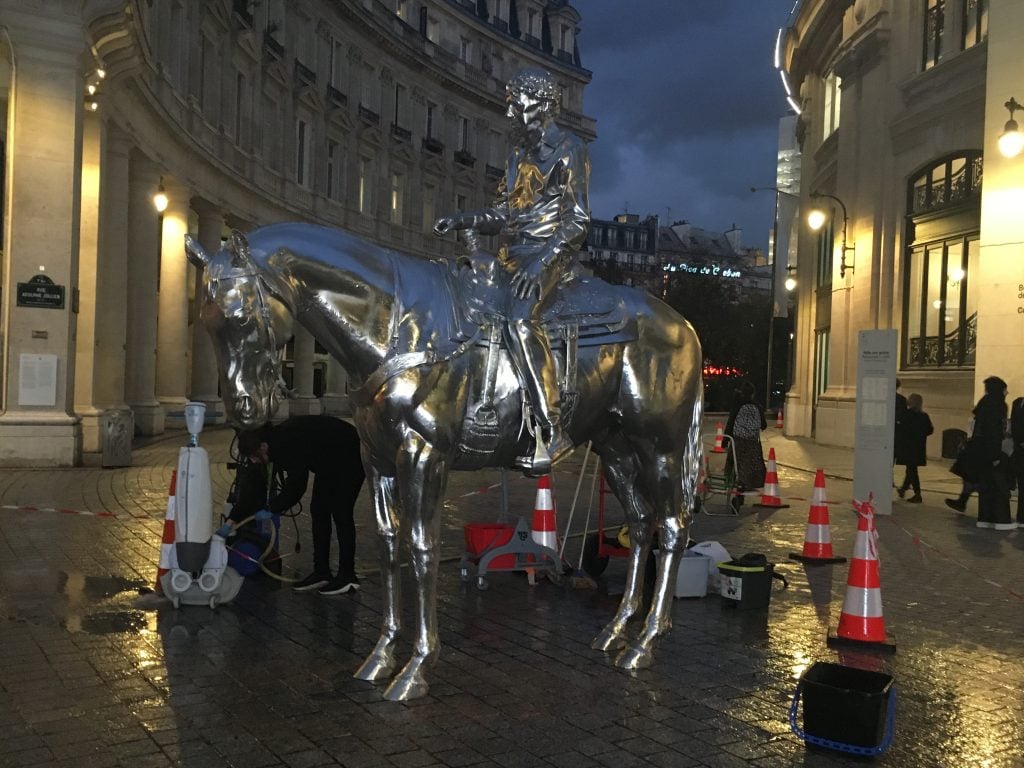
Charles Ray’s sculpture after a thorough cleaning on Friday, November 18. Photo: Anna Sansom.
Between May 29, 2020 and this column’s publication, climate demonstrators targeted 21 different artworks at European museums, as well as a replica mummy and a dinosaur display. The most recent of these incidents breached distressing new ground that bodes ill for the year ahead.
In mid-November, two members of the French activist group Dernière Rénovation (Last Renewal) doused Charles Ray’s sculpture Horse and Rider (2014) in orange paint outside the Bourse de Commerce – Pinault Collection. In all earlier actions, protesters either chose to go after artworks protected by glass, or deliberately only touched the elements surrounding exposed artworks (see: handrails, plinths, etc.).
Conservators were able to prevent any actual damage to the Ray piece after a two-and-a-half-hour emergency cleaning. But by targeting a completely vulnerable artwork for the first time, the French demonstrators have escalated the larger campaign from publicity stunts intended to be harmless to outright attacks. It’s a bell that can’t be unrung, and it’s going to signal some less conscientious or more desperate actor to go too far soon.
The forward rush of artificial intelligence makes our existing regulatory framework more inadequate every day, and nowhere is this more apparent than in matters of copyright and intellectual property. I expect the tensions to come to a head in the visual arts this year.
Text-to-image generators like Dall-E, Midjourney, Stable Diffusion, and (most recently) Google’s Imagen work by “training” on billions of image files sucked up from across the web. Surprisingly few guardrails govern what can be input for study or what can be output by the algorithms. Attempts to impose stricter limits have even provoked backlash from some users, to the likely detriment of artists.
The problems are vast and multiplying. Zachary Small reported last fall that one popular training archive contained photos of artworks by Jeff Koons, Kerry James Marshall, Cindy Sherman, and a host of other living blue-chip artists. Commercial illustrators are even more vulnerable; Greg Rutkowski, a major contributor of artwork to videogames and fantasy outlets, has had his name used in more prompts than Picasso on at least one text-to-image generator, with fans frequently mistaking the outputs as his original works.
Another platform sparked outrage after the remnants of artists’ signatures appeared in the algorithmically generated images. Grassroots protests and calls for boycotts are proliferating. The whole situation is getting out of hand.
While some legal experts contend that it would be an uphill battle for any litigant to prevail in court against the maker of an A.I. image generator, there is enough anger and uncertainty out there to spur someone to try anyway. A class-action suit joined by dozens of lesser-known artists seems most likely to me. Lawmakers’ antennae are up on the issue, too, especially in Europe, where tech companies were viewed as for-profit businesses run amok well before the U.S. techlash began. If every algorithm developer is lucky enough to stay out of the courts, I expect at least one of them to be called in for hearings or notified they’re the subject of a government investigation.